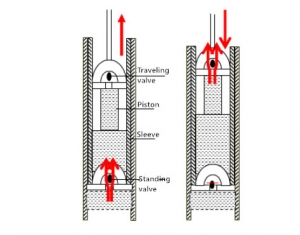OIL FIELD TUBING PUMP
The tubing pump is also referred to as the oil tubing pump. The barrel assembly of the tubing oil pump is directly connected to the lower end of the tubing and the plunger goes into the pump barrel with the sucker rod. The tubing pump consists of a pump barrel, a fixed valve and a hollow plunger with a traveling valve.
The bushing joints line into the inner part of the outer barrel. The piston is a hollow cylinder made of seamless steel tubes with a smooth surface and a ring groove. It allows sand particles to accumulate in the groove. The lubricating oil in the groove protects the surface of the piston from sand particles.
The salvageable suction valve can drain the oil in the oil pipe, and pull out the suction valve by lowering the rod column and clamping the hook at the lower end of the piston to bite the suction head of the suction valve. However, the fishing head occupies more space in the pump to increase the anti-impact distance and clearance volume of the pump, which is easy to be affected by gas and reduce pump efficiency. In most Wells, a tubing pump is installed below the tubing to remove the oil from the tubing. Because the diameter of the piston is larger than the tubing, it cannot be inserted into the piston along with the tubing. In general, the piston is first tubing down into the well, then down the sucker rod string, and a disconnector is used to dock with the piston in the pump.
The principle of oil field tubing pump
During the pump process, the plunger moves up and down with the sucker rod in the pump barrel. During the upstroke, the traveling valve ball on the plunger closes and the fixed valve ball is opened. The plunger will drain the oil in the upper chamber to the oil pipe of the pump. At this time, the oil will enter the lower chamber of the pump barrel through the fixed valve under the inlet pressure. When down-stroke, the fixed valve is closed and the traveling valve is opened, the oil in the lower chamber of the pump enters the upper chamber of the pump barrel through the plunger.
The application oil field tubing pump
The tubular pump has a simple structure, low cost, large displacement, easy maintenance and low initial cost. The allowable pump diameter range of the same tubing diameter is larger than that of the rod pump. However, the oil pipe must be pumped when the pump is checked, and the workover workload is large, so it is suitable for coal-bed methane Wells with low pump depth and high production. It also has some shortcomings such as severe pipe wear, poor adaptability of coal powder and poor adaptability of a horizontal well.
OIL FIELD ROD PUMP
Rod pump, also known as insert pump, the fixed rod pump features an inside and outside working barrel, outside the working barrel, top with the vertebral body and circlip (circlip position under the pump depth), when the pump is placed outside the cylinder with the tubing down into the well, and then work with liner, piston-cylinder meets outside on the lower end of the rod into the working barrel and fixed by a spring. In addition, there is a fixed rod pump fixed in the bottom of the pump barrel, and a moving cylinder bottom fixed rod pump with the rod-driven pump barrel reciprocating movement.
Rod pump is an integral deep well pump without bushing, can be divided into top fixed (RHA, RWA), bottom fixed (RHB, RWB) according to its structure; consist of by the plunger built-in pump assembly, external fixed assembly two parts. The sucker rod is the key part of the rod pump. It connects the pumping unit to the pumping unit and transfers the power of the pumping unit to the pumping unit.
The principle of oil field rod pump
Like tubing pumps, rod pumps rely on reciprocating plunger movements to pump oil to the ground. During the upward stroke, the fixed and annular valves are opened, the traveling valves are closed, the well fluid is flushed from the well pump barrel, and the liquid on the plunger is sucked to the ground; During the downstroke, the traveling valve opens, the fixed valve and the ring valve close to form a secondary compression, and the well fluid flows to the plunger through the traveling valve.
The application of oil field rod pump
Rod pump is easy to repair, even in the case of no need to lift out of the tubing, but only need to lift out of the sucker rod, which reduced workload and intensity. However, it also has the disadvantages of a complex structure, easy wear and high manufacturing cost. The pump diameter allowed under the same tubing diameter is smaller than that of tubing pump. It is suitable for straight and inclined wells with larger pump depth and smaller output (well inclination <75゜) or sand, coal well.

